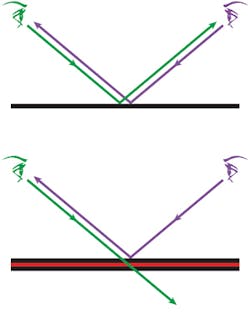Spatiotemporally modulated optical mirror reflects in one direction, transmits in the other

In an ordinary optical system, rays that can be traced through the system one way can then be traced backwards along the path of the original ray back to its origin. In a nonreciprocal optical system, this is not necessarily so. For example, a nonreciprocal mirror might reflect a light ray coming from one direction, but transmit a ray that follows the reverse path of the original reflected ray (note that we are not talking here about devices like conventional acousto-optic isolators that work by frequency conversion of light and subsequent filtering). In waveguide optics, a nonreciprocal effect can be achieved by modulating the refractive index of the waveguide in time and space by Brillouin-scattering-induced transparency or by other effects such as nonreciprocal optical Faraday rotation and structural chirality. In waveguides, light takes a single direction, making nonreciprocity easier to achieve. In bulk optics, however, light takes many directions, complicating matters immensely.
Researchers at the University of Texas at Austin and the École Polytechnique Fédérale de Lausanne (Lausanne, Switzerland) have come up with a way to create a bulk nonreciprocal mirror that, at least in theory, can have a 50 dB isolation and a very high reflection. If an ordinary mirror (top in figure) is replaced by a thin, flat Fabry-Perot (F-P) cavity (bottom in figure) and an acoustic wave is sent along the cavity (red line) in one direction, the symmetry of the cavity is broken and the possibility exists for nonreciprocal optical properties. In this figure, which shows two observers (eyes), one observer could thus see the other without being seen.
In computer simulations, the F-P cavity is made of a dielectric slab (say, 1 mm thick) of acousto-optic material between two surfaces that each reflect close to 100%. With modulation frequencies of hundreds of megahertz and a small refractive index modulation of Δn/n in the range of 10-5 to 10-6 (achievable by real acousto-optics), a deep (although narrowband) spectral dip in reflection in one direction forms, while the reflection in the other direction stays at close to 100%. Reference: R. Fleury et al., arXiv:1709.00702 [physics.optics] (Sep. 3, 2017).
About the Author
John Wallace
Senior Technical Editor (1998-2022)
John Wallace was with Laser Focus World for nearly 25 years, retiring in late June 2022. He obtained a bachelor's degree in mechanical engineering and physics at Rutgers University and a master's in optical engineering at the University of Rochester. Before becoming an editor, John worked as an engineer at RCA, Exxon, Eastman Kodak, and GCA Corporation.
